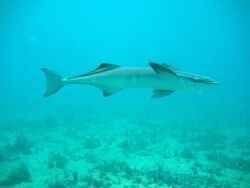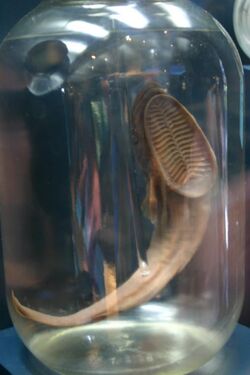Biology:Common remora
| Common remora | |
|---|---|

| |
| Scientific classification | |
| Domain: | Eukaryota |
| Kingdom: | Animalia |
| Phylum: | Chordata |
| Class: | Actinopterygii |
| Order: | Carangiformes |
| Family: | Echeneidae |
| Genus: | Remora |
| Species: | R. remora
|
| Binomial name | |
| Remora remora | |
| Synonyms[2] | |
| |
The common remora (Remora remora) is a pelagic marine fish[3] belonging to family Echeneidae. The dorsal fin, which has 22 to 26 soft rays, acts as a suction cup, creating a vacuum[4] to allow it to attach to larger marine animals, such as whales, dolphins, sharks, and sea turtles.[5]
Physical characteristics
The common remora has a suckerlike dorsal fin and an anal fin. Its body can be brown, black or grey in color.[6] This species can reach 86.4 cm (34.0 in) in total length, though most do not exceed 40 cm (16 in).[2] The maximum known weight of this species is 1.1 kg (2.4 lb).[2]
Biology and behavior
R. remora and its host seem to partake in a symbiotic relationship; the common remora does not seem to have a negative overall effect on its host. The host provides the remora with fast-moving water to bathe its gills, a steady flow of food, transportation, and protection.[7] The remora benefits the host by feeding in part on some of its parasites, but increases its hydrodynamical drag. The common remora's attachment to one host can last for up to three months.[8] During this time, the remora can move its attachment site if it feels threatened.[9] The common remora cannot survive in still water; it needs water flow over its gills to provide it oxygen.
Habitat
This remora is commonly found in warm marine waters and have been seen in the western Mediterranean and the Atlantic, as well as the North Sea.[1]
Reproduction
A mating couple may attach to the same host, and have host fidelity.[10] It is not clear when during the year the common remora spawns, and little is known about the fish's reproductive behavior.
Food and diet
The remora consumes food scraps from its host, as well as plankton and parasitic copepods.
Significance to humans
No known negative impacts for humans are known. Remoras can be caught as fishing bycatch and put in aquaria.[11] Remoras have been used in fishing - one method involves tying fishing line to the remora, then waiting for it to cling to a larger fish.[12]
Other common names for this familiar fish include suck fish, stout sucking fish, common sucker, shark-sucker, brown sucker, and shark pilot.[1]
References
- ↑ 1.0 1.1 1.2 Curtis, M.; Williams, J.T.; Collette, B.; Smith-Vaniz, W.F.; Pina Amargos, F.. "Remora remora (errata version published in 2017)". IUCN Red List of Threatened Species 2015: e.T198651A115343508. doi:10.2305/IUCN.UK.2015-4.RLTS.T198651A15544903.en. https://www.iucnredlist.org/species/198651/115343508.{{cite iucn}}: error: |doi= / |page= mismatch (help)
- ↑ 2.0 2.1 2.2 Froese, Rainer and Pauly, Daniel, eds. (2013). "Remora remora" in FishBase. April 2013 version.
- ↑ Leao, Mark (2002). "Remora remora (on-line)". in Kimberly Schulz. Animal Diversity Web. http://animaldiversity.ummz.umich.edu/site/accounts/information/Remora_remora.html. Retrieved 2009-06-02.
- ↑ Fishes of the World, 3rd edition. Joseph S. Nelson. New York, NY: John Wiley and Sons, Inc, 1994. p. 351
- ↑ Sazima, I.; Grossman, A. (2006). "Turtle riders: Remoras on marine turtles in Southwest Atlantic". Neotropical Ichthyology 4: 123–126. doi:10.1590/S1679-62252006000100014.
- ↑ Smith's Sea Fishes, 6th edition. Edited by Margaret M. Smith and Phillip C. Heemstra. New York, NY: Springer-Verlag, 1986. p. 662
- ↑ Fertl, D.; Landry, A. M. (1999). "Sharksucker (Echeneis naucrates) on a Bottlenose Dolphin (Tursiops tTruncatus) and a Review of Other Cetacean-Remora Associations". Marine Mammal Science 15 (3): 859. doi:10.1111/j.1748-7692.1999.tb00849.x.
- ↑ Sazima, I.; Sazima, C.; Silva-Jr, J. M. D. (2006). "Fishes associated with spinner dolphins at Fernando de Noronha Archipelago, tropical Western Atlantic: An update and overview". Neotropical Ichthyology 4 (4): 451. doi:10.1590/S1679-62252006000400009.
- ↑ Silva-Jr, J. M.; Sazima, I. (2009). "Whalesuckers on spinner dolphins: An underwater view". Marine Biodiversity Records 1. doi:10.1017/S1755267206002016.
- ↑ Silva-Jr, J. M.; Sazima, I. (2003). "Whalesuckers and a spinner dolphin bonded for weeks: Does host fidelity pay off?". Biota Neotropica 3 (2): 1. doi:10.1590/S1676-06032003000200012.
- ↑ Grzimek’s Animal Life Encyclopedia, 2nd edition. Volume 5, Fishes 11, edited by Michael Hutchins, Dennis A. Thoney, Paul V. Loiselle, and Neil Schlager. Farmington Hills, MI: Gale Group, 2003. p. 216
- ↑ Fishes, Ascidians, etc. Vol. 7. Edited by Sir S.F. Harmer and Sir A.E. Shipley. London: McMillan and Co., Limited. 1932. p. 691
External links
- Photos of Common remora on Sealife Collection
Wikidata ☰ Q749460 entry



